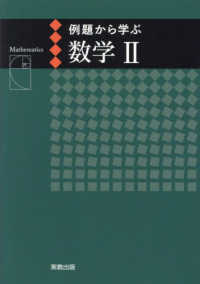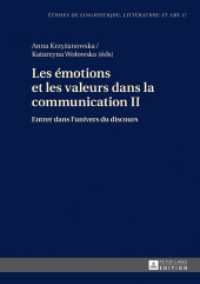- ホーム
- > 洋書
- > 英文書
- > Cinema / Film
Full Description
One of the most visually striking traditions in cinema, for too long Expressionism has been a neglected critical category of research in film history and aesthetics. The fifteen essays in this anthology remedies this by revisiting key German films like The Cabinet of Dr. Caligari (1920) and Nosferatu (1922), and also provide original critical research into more obscure titles like Nerven (1919) and The Phantom Carriage (1921), films that were produced in the silent and early sound era in countries ranging from France, Sweden and Hungary, to the United States and Mexico.
An innovative and wide-ranging collection, Expressionism in the Cinema re-canonizes the classical Expressionist aesthetic, extending the critical and historical discussion beyond pre-existing scholarship into comparative and interdisciplinary areas of film research that reach across national boundaries.
Contents
Acknowledgements; Editors' Introduction; Section I: Expressionism in German Cinema; Expressionist Cinema: Style and Design in Film History, Thomas Elsaesser; Of Nerves and Men: Postwar Delusion and Robert Reinert's Nerven, Steve Choe; Franjo Ledić: A Forgotten Pioneer of German Expressionism, Daniel Rafaelić; Expressionist Film and Gender: Genuine, A Tale of a Vampire (1920), Mirjam Kappes; 'The Secrets of Nature and Its Unifying Principles': Nosferatu (1922) and Jakob von Uexküll on Umwelt, Steve Choe; Raskolnikow (1923): Russian Literature as Impetus for German Expressionism, John T. Soister; Section II: Expressionism in Global Cinema; The Austrian Connection: The Frame Story and Insanity in Paul Czinner's Inferno (1919) and Fritz Freisler's The Mandarin (1918), Olaf Brill; 'The rewakening of French cinema': expression and innovation in Abel Gance's J'accuse! (1919), Paul Cuff; Here Among the Dead: The Phantom Carriage (1921) and the Cinema of the Occulted Taboo, Robert Guffey; Drakula halála (1921): The Cinema's First Dracula, Gary D. Rhodes; Le Brasier ardent (1923): Ivan Mosjoukine's clind'œil to German Expressionism, Bernard McCarron; Nietzsche's Fingerprints on The Hands of Orlac (1924), Phillip Sipiora; 'True, Nervous': American Expressionist Cinema and the Destabilized Male, Robert Singer; Dos monjes (1934) and the Tortured Search for Truth, David J. Hogan; Maya Deren in Person in Expressionism, Graeme Harper; Author Biographies; Index








